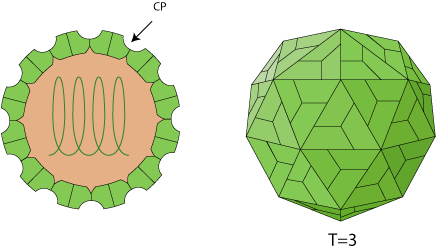VIRION

Non-enveloped, spherical, icosahedral, about 28-34 nm in diameter, capsid with a T=3 icosahedral symmetry. 30 hexameric capsomers per nucleocapsid (virion composed of 180 protein subunits).
GENOME
Linear, ssRNA(+) genome of 4-5.4 kb, which lacks a cap structure and a poly(A)tail.
GENE EXPRESSION
The virion RNA is infectious and serves as both the genome and viral messenger RNA. The ORF2 is expressed by leaky scanning of the genomic RNA. Two 5'-proximal ORFs are directly translated to produce the viral constituents of the replicase complex. RdRp is translated through suppression of termination at the end of ORF1. ORF3-RT is also expressed through suppression of termination at the end of ORF3.
Cap-independent translation is mediated possibly through the interaction between a 3'-cap-independent translation element and a 5'UTR stem-loop.
ENZYMES
REPLICATION
CYTOPLASMIC
- Virus penetrates into the host cell.
- Uncoating, and release of the viral genomic RNA into the cytoplasm.
- The viral RNA is translated to produce the two proteins necessary for RNA synthesis (replication and transcription).
- Replication takes place in cytoplasmic viral factories. A dsRNA genome is synthesized from the genomic ssRNA(+).
- The dsRNA genome is transcribed/replicated thereby providing viral mRNAs/new ssRNA(+) genomes.
- The RdRp recognizes internal subgenomic promoters on the negative-sense RNA to transcribe the 3'co-terminal subgenomic RNAs that will generate the capsid and ORF3/ORF3-RT proteins.
- Virus assembly in the cytoplasm.

